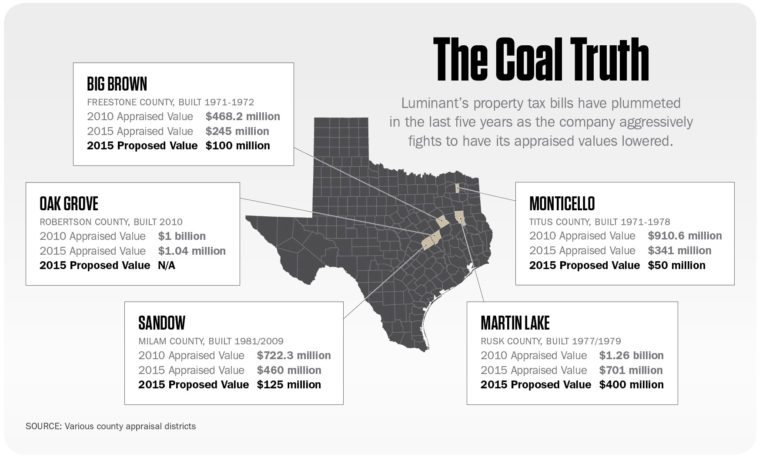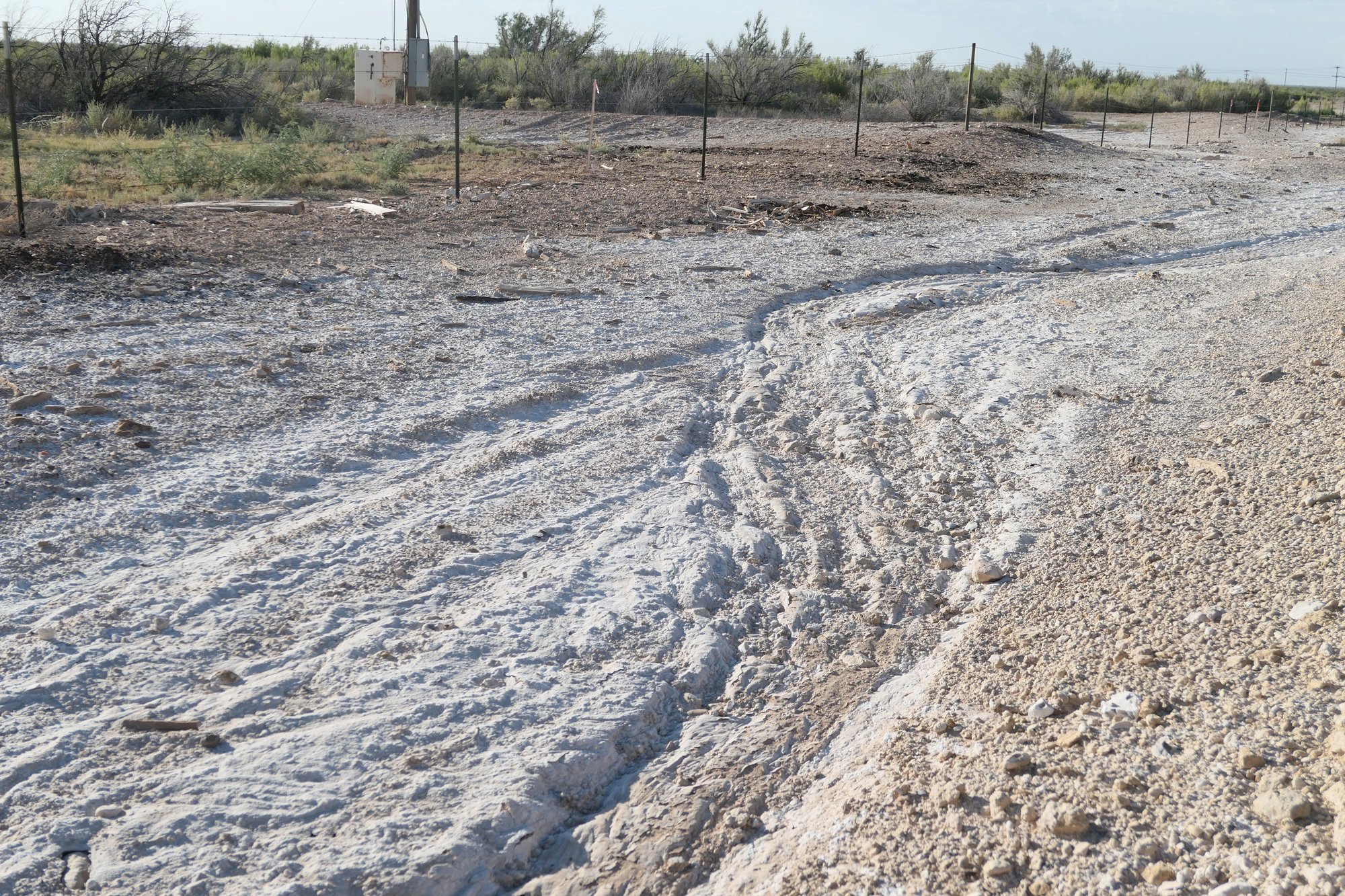
Powering Down
The owner of Texas’ biggest fleet of coal-fired power plants is trying to wiggle out of paying its property taxes.
A version of this story ran in the July 2016 issue.
Judd Marshall watched with a grin last August as middle school students celebrated the first day of school by throwing wads of paper at each other — a brief exercise in chaos allowed by their teacher. The young superintendent of Mount Pleasant ISD in Northeast Texas planned to visit all eight campuses that day, a yearly tradition.
His tie already loosened by mid-morning as the temperature climbed toward 90, Marshall clearly enjoyed watching the students horse around. “Really, for us it’s just a welcome back to school for the teachers and students,” he said.
The tour was also a brief respite from budget woes weighing heavily on Marshall. Earlier that month, Titus County’s biggest taxpayer, Luminant Corp., had dropped a fiscal bomb on the district, where 84 percent of students are considered economically disadvantaged and 68 percent are Hispanic: It claimed its aging Monticello coal-fired power plant is only worth one-seventh of its recently appraised value of $341 million. A few days later, Luminant filed suit against the appraisal district in Titus County. Under state law, Luminant will pay taxes only on its self-proclaimed valuation as long as the litigation is ongoing.

Overnight, more than 10 percent of Mount Pleasant ISD’s budget, about $4.2 million in tax revenue, simply disappeared. In the last year, Luminant has filed lawsuits contesting appraisals of its coal-fired plants in the four other rural counties where it owns coal plants (Rusk, Freestone, Milam and Robertson), mostly in East Texas, forcing schools, community colleges, hospitals and local governments into financial straits. It also sued in Somervell County, where it operates the Comanche Peak nuclear plant. So far, only the Comanche Peak dispute has gone to trial. In March, a state district judge ruled against the company and upheld the appraisal district’s valuation of the nuclear plant. The company filed an appeal June 1.
Over the last eight years, Luminant has used Texas’ industry-friendly property tax protest system to whittle away at its bill. Just eight years ago, in 2008, the Monticello plant was appraised at $1.05 billion. Today, Luminant claims the plant is worth only $50 million — that it has lost 95 percent of its value in eight years. Even if the appraisal district wins in court, the plant’s current taxable value of $341 million has dropped by more than two-thirds since 2008, taking millions of dollars off the tax rolls for Mount Pleasant ISD, Northeast Texas Community College, Titus County and the Titus County Hospital District. Under Texas law, Luminant and other big industrial taxpayers can sue to drastically lower their property valuations, often forcing local governments to cut budgets and raise taxes to make up for the lost revenue.
Luminant’s pattern over the past several years has been to sue and then negotiate a settlement within a few months. But it looks like the company is playing hardball this time. Instead of negotiating, Luminant has simply waited for the suit to be heard — even as the 2016 appraisals have been released.
Marshall is skeptical of Luminant’s claims, pointing out that in 2014 the company had agreed to a $350 million valuation.
“They publicly say they want to pay their fair share. They just want to determine what ‘fair’ is,” he said. “We were backed in a corner. A $50 million valuation is ridiculous.”
Marshall is left with few options. Mount Pleasant ISD’s tax rate is already at the legal limit. In late August, at Marshall’s urging, the school board eliminated a local homestead exemption, raising homeowners’ tax bill collectively by $800,000. It was not a popular move in this conservative and poor county.
Eliminating the exemption only cut the deficit by about one-fifth. The board and Marshall came up with the remainder by freezing wages, raising insurance premiums for all employees, delaying maintenance and dipping into savings. Now, district administrators are at work preparing next year’s budget, and they are assuming Luminant will contest the 2016 appraisal, too, and file yet another lawsuit.
If Luminant loses, it will have to pay the unpaid taxes as well as penalty and interest. If Luminant prevails, the state will eventually replace the lost tax revenue. Essentially, other taxpayers around the state would have to cover the costs through the school finance system.
Titus County, the hospital district and the Northeast Texas Community College District have had to make up the difference on their own, with no help from the state, through layoffs, tax increases and budget cuts.
On its website, Luminant brags that “Few businesses have devoted more money, time and effort to the social and economic development of Texas than Luminant has.” And indeed its power plants have provided jobs and a tax base for several rural towns. But that social contract is under tremendous strain.
Dick Lavine with the Center for Public Policy Priorities, a liberal Austin think tank, summed it up succinctly: “If Luminant won’t pay its taxes, then the hardworking folks of Titus County will have to pick up the tab.”

Under Texas law, homeowners and big industrial interests have the same rights to contest their property tax bill. First, you can file an appeal with the local tax appraisal district, typically arguing an appraisal is too high based on comparable properties. That protest is heard by an appraisal review board, whose members are chosen in smaller counties by the board of the appraisal district. If that protest doesn’t work, your other option is to sue.
But very few homeowners have the resources to hire high-priced attorneys who understand the arcane world of Texas property tax law. For large companies such as Luminant, with deep pockets, considerable legal resources and the chance to save millions, suing appraisal districts is a no-brainer.
In the Panhandle, Valero Energy Corp. sued Moore County five years in a row to avoid paying its full property tax bill for a refinery it bought in 2003. In Freestone County, home of the Big Brown coal plant — a heavily polluting ’70s-era behemoth — Luminant sued in 2011, 2012 and 2013, but ultimately settled for markedly lower appraisals. From 2011 to 2013, Big Brown’s appraised value dropped from $380 million to $245 million, a 36 percent reduction in the tax bill. Now, Luminant is claiming the plant is worth just $100 million.
Other coal plant owners are pursuing lawsuits to reduce their tax bills as well. The Sandy Creek plant in Riesel, near Waco, was completed in 2013 at a cost of $1.2 billion, according to the Waco Tribune-Herald. Its owners sued last year, claiming the plant is now only worth $253.5 million, in hopes of lowering its tax bill by $2.5 million.
Just eight years ago, in 2008, the Monticello plant was appraised at $1.05 billion. Today, Luminant claims the plant is worth only $50 million — that it has lost 90 percent of its value in eight years.
“We believe the counties’ valuations of our coal plants vastly exceed their market values,” Luminant spokesperson Brad Watson said.
It’s certainly the case that coal’s fortunes have dimmed in recent years. Stricter pollution standards, the advent of regulations on climate-heating greenhouse gases, and the increasing competitiveness of renewable power have squeezed dirty fossil fuels.
On those points, the appraisers and Luminant largely agree. The dispute is over how much property values have declined, an inexact science made all the more difficult, appraisers say, by big companies’ refusal to share financial information that might help inform a valuation.
Geraldine Hull, Titus County’s chief appraiser, said Luminant repeatedly declines to provide underlying information for how it derived a $50 million value for its Monticello plant. “We have asked on many occasions for additional information. Their response is that is proprietary information, and they don’t have to disclose that,” Hull said.
Titus County hired Charles Rush, an appraiser for Pritchard & Abbott who specializes in industrial properties, to do the hard work of coming up with an appraisal for the Monticello plant. In June, Rush testified before the Titus County appraisal review board that he took into account the low cost of electricity and its negative effect on coal-fired plants. In calculating income, Rush has to rely on market figures, since Luminant won’t provide any.
How did Luminant come up with $50 million? Rush suggested it was a fanciful figure. “Call it scrap value. Call it what you want. I don’t know what the heck it is,” Rush said.
When asked if Luminant would sell the Monticello plant for $50 million, Watson said the company isn’t “inclined to address a hypothetical situation.” But he said there’s “little incentive to buy coal plants,” because they are so “financially challenged.”
Still, the seeds of Luminant’s tax-shedding strategy were planted by the company itself in 2007. That’s when two private equity firms purchased TXU, Luminant’s predecessor parent company, for a record $45 billion in debt and cash, creating Energy Future Holdings (EFH), the parent of Luminant and subsidiaries Oncor and TXU Energy.
The leveraged buyout proved to be a disaster. The buyers made a huge gamble that natural gas prices would remain high. In Texas’ deregulated power market, natural gas largely determines wholesale power prices. If gas is costly, nuclear and coal plants can make a killing. But natural gas prices plummeted, pushing debt-laden EFH inexorably toward bankruptcy. EFH filed for bankruptcy in April 2014 in Delaware.
Last year, EFH tried, unsuccessfully, to persuade the bankruptcy trustee to take control of the state property tax disputes. A motion filed in bankruptcy court shows that EFH has a thought-out strategy to “right-size their property tax liabilities,” as the company put it. Luminant indicates in the motion that its goal is to shed at least $40 million in property taxes across its five coal plants and Comanche Peak nuclear plant. (The company boasts on its website that it paid more than $95 million statewide in property taxes in 2014, so it hopes to reduce that liability by more than 40 percent.)
But Luminant itself has offered wildly different estimates of its plants’ values, depending on whether it serves the company’s purpose. An Observer review of records at county appraisal districts, the bankruptcy court and the Texas Railroad Commission, which oversees coal mining, shows how disparate the valuations can be.
In 2014, Luminant reported to the Railroad Commission that its Sandow, Comanche Peak, Martin Lake and Monticello power plants were worth a collective $4.3 billion. The filing was part of an assessment of EFH’s ability to cover the financial costs of cleaning up its coal mines. But in individual lawsuits against county appraisal districts, the company has claimed those four plants are only collectively worth about $2.1 billion. In bankruptcy court, Luminant claimed that its Sandow units are worth $350 million, but to the Milam County Appraisal District it estimates a value of $125 million.
Such inconsistencies are a sign that the company is misrepresenting the financial value of its assets to suit its goal, according to Todd Stewart, an attorney representing Titus and Robertson counties’ appraisal districts.
“As is not uncommon with many tax consultants, they’re playing both sides of the fence,” Stewart told the Observer. “If their client needs a value sufficient to prove they have the financial capability to clean up [mines], we’re worth a gajillion dollars. But if you want me to sell it and liquidate it, then for tax purposes it’s worth nothing.”
Watson said that the valuations are so different, in part, because the Railroad Commission and tax appraisers don’t share the same definition of taxable assets.

Luminant has promised to “work with a county appraisal district to determine the fair taxable valuation for our power plants and mines,” Watson wrote in an op-ed for the Mount Pleasant Daily Tribune last year that still serves as the company’s chief argument against the higher valuations. But nobody from Luminant showed up at any of the appraisal review board hearings in 2015.
According to Marshall, the Mount Pleasant superintendent, a couple of Luminant tax lawyers, a vice president and a public relations specialist met with him and other local officials in February 2015, six months before filing suit. At the time, Luminant officials promised better communication in order to avoid legal confrontations.
That is the last time any Titus County official heard from Luminant.
Watson said the company’s “goal is always to work with county appraisal districts to determine the taxable valuation for our power plants. We’ve done it this way for years.”
Titus County Judge Brian Lee, who attended the meeting with Luminant, was also surprised by the $50 million value the company placed on the Monticello plant.
“They never gave an inkling on how low they were going to go,” he said. The lower plant valuation cost the county $1.2 million in tax revenue.
Northeast Texas Community College (NTCC), with about 3,500 students, was already dealing with cuts in state funding from a parsimonious state Legislature. It lost nearly $300,000 annually in property tax revenue when Luminant filed suit. Combined with a decline in enrollment last spring, Dr. Brad Johnson, NTCC president, said the college has cut seven permanent positions, frozen wages, cut all deferred maintenance and canceled the last two years of a marketing contract to increase enrollment.
While appraisers and utilities haggle over taxes on coal plants, economics and environmental concerns are systematically shutting them down. Last summer, the Sierra Club trumpeted the closing of the 200th coal plant in the country. Not only is coal responsible for a large share of smog-forming gases, mercury contamination in fish and lung-scorching soot, its contribution to climate change is enormous. Scientists and environmentalists argue that replacing coal-fired power with solar, wind and other renewable sources is one of the best ways to ratchet down greenhouse gas emissions.
“We need them for a number of years, but we don’t need them forever,” said Al Armendariz, a former regional EPA administrator for Texas who now runs the Sierra Club’s Beyond Coal campaign in Texas and neighboring states. “Let’s phase them out over the next 10 years and take care of the communities where these plants are located.”
“If Luminant won’t pay its taxes, then the hardworking folks of Titus County will have to pick up the tab.”
“We are not seeing that type of interest in Texas, because our state elected officials are more interested in grandstanding, suing the EPA at every opportunity,” Armendariz said.
For now, the Monticello plant — with its three towering stacks — still looms large over Titus County. Lake Monticello, which provides cooling water for the plant, is one of most popular bass fishing lakes in the state. Railroad cars carrying coal from Wyoming’s Powder River Basin still rumble in, bringing astonishing amounts of black rock to burn.
But in perhaps a harbinger of things to come, the three nearby Luminant-owned mines that used to supply Big Brown with lignite — a sulfurous and dirty form of coal — closed earlier this year. Eighty workers lost their jobs.
Tom “Smitty” Smith, state director of Public Citizen, the consumer and environmental advocacy group, predicts the plants could shut down within five years. “They’re going to be too expensive to operate,” he said. “Obviously it’s going to be devastating to East Texas to have these plants devalued. … My heart goes out to them.”
Additional reporting by Naveena Sadasivam.


